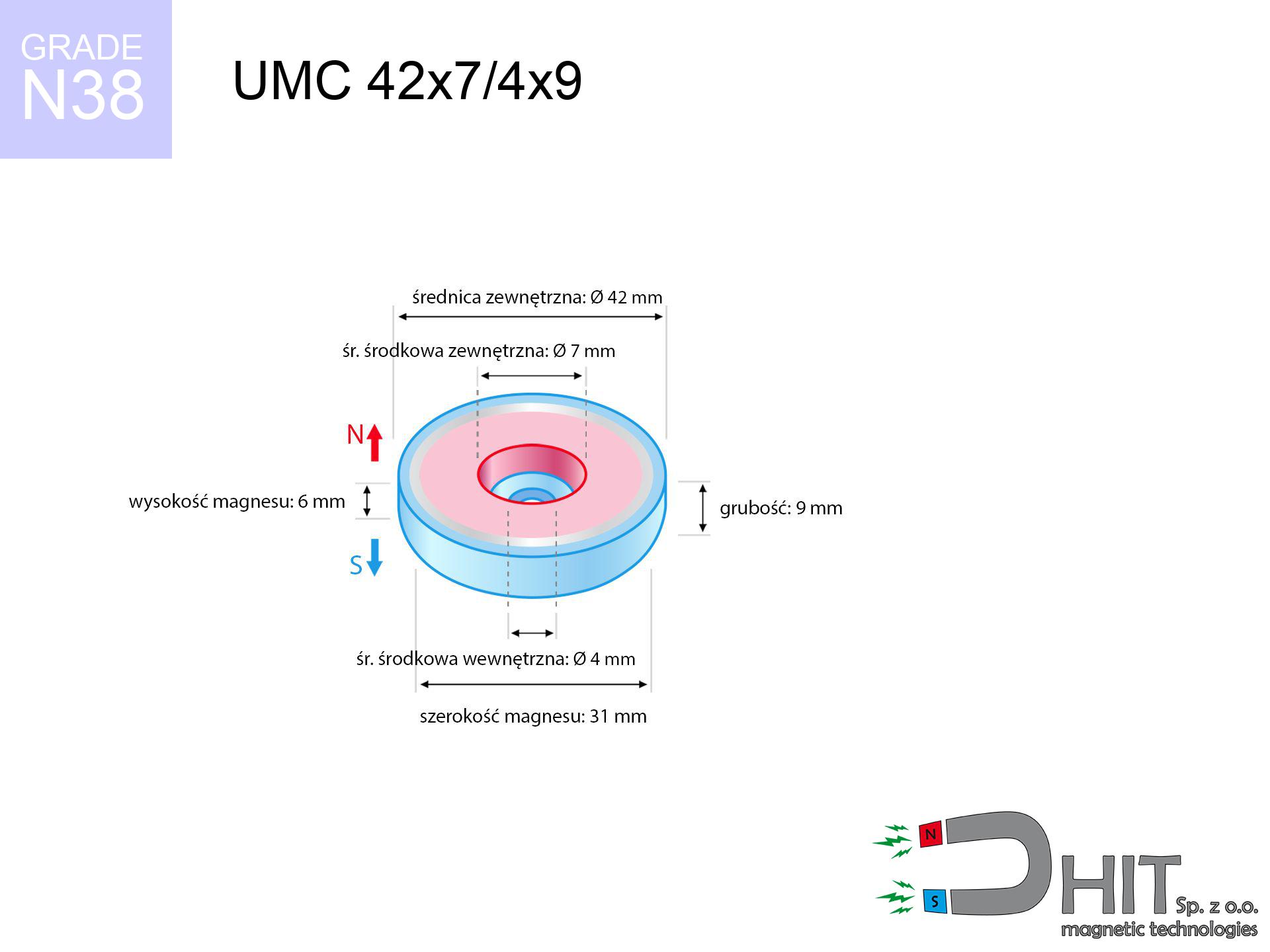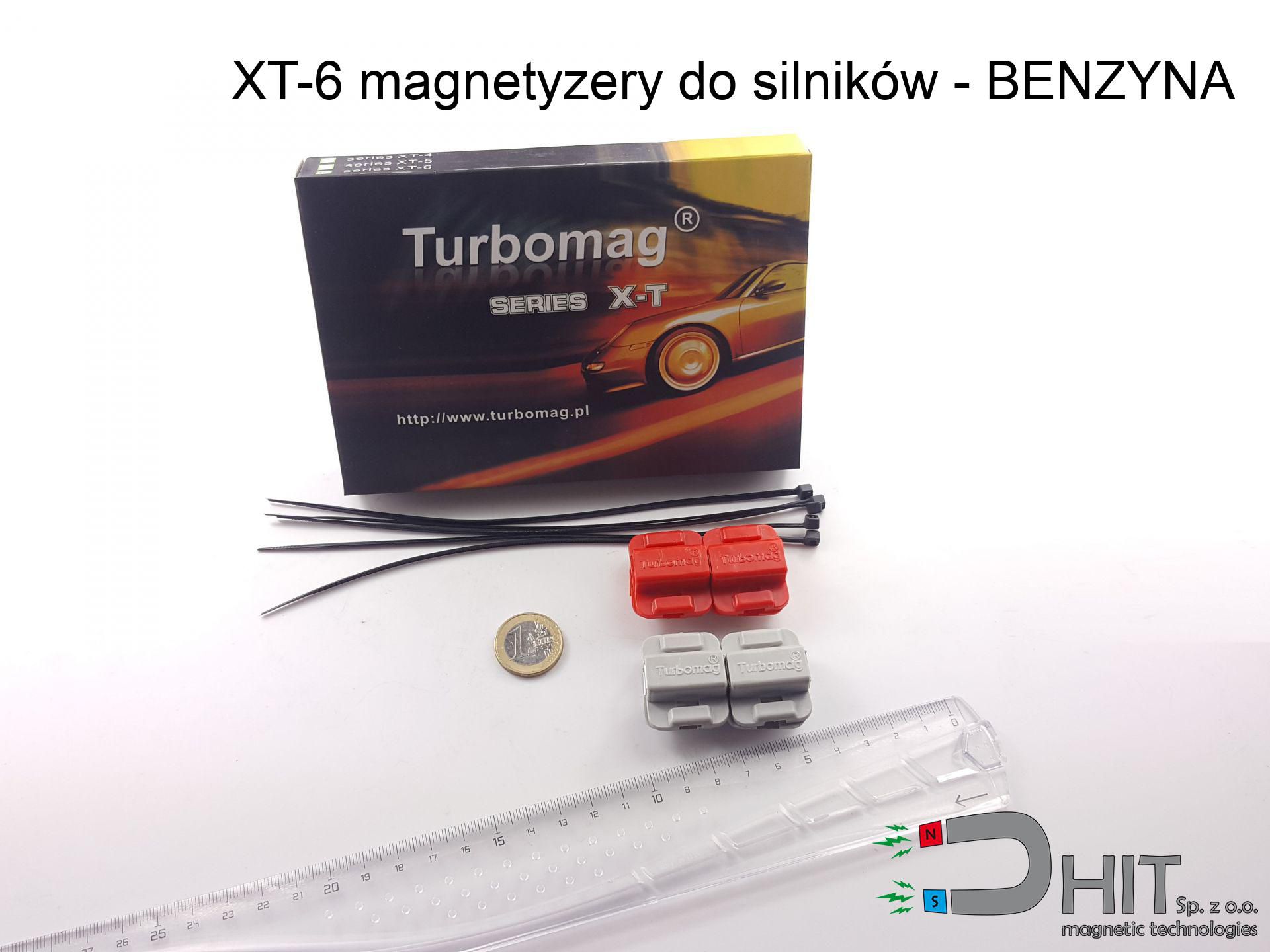UMC 42x7/4x9 / N38 - cylindrical magnetic holder
cylindrical magnetic holder
Catalog no 320411
GTIN/EAN: 5906301814672
Diameter
42 mm [±1 mm]
internal diameter Ø
7/4 mm [±1 mm]
Height
9 mm [±1 mm]
Weight
72 g
Load capacity
32.00 kg / 313.81 N
Coating
[NiCuNi] Nickel
29.99 ZŁ with VAT / pcs + price for transport
24.38 ZŁ net + 23% VAT / pcs
bulk discounts:
Need more?
Contact us by phone
+48 888 99 98 98
alternatively get in touch using
contact form
our website.
Weight as well as structure of magnets can be reviewed using our
force calculator.
Orders placed before 14:00 will be shipped the same business day.
Physical properties - UMC 42x7/4x9 / N38 - cylindrical magnetic holder
Specification / characteristics - UMC 42x7/4x9 / N38 - cylindrical magnetic holder
| properties | values |
|---|---|
| Cat. no. | 320411 |
| GTIN/EAN | 5906301814672 |
| Production/Distribution | Dhit sp. z o.o. |
| Country of origin | Poland / China / Germany |
| Customs code | 85059029 |
| Diameter | 42 mm [±1 mm] |
| internal diameter Ø | 7/4 mm [±1 mm] |
| Height | 9 mm [±1 mm] |
| Weight | 72 g |
| Load capacity ~ ? | 32.00 kg / 313.81 N |
| Coating | [NiCuNi] Nickel |
| Manufacturing Tolerance | ±1 mm |
Magnetic properties of material N38
| properties | values | units |
|---|---|---|
| remenance Br [min. - max.] ? | 12.2-12.6 | kGs |
| remenance Br [min. - max.] ? | 1220-1260 | mT |
| coercivity bHc ? | 10.8-11.5 | kOe |
| coercivity bHc ? | 860-915 | kA/m |
| actual internal force iHc | ≥ 12 | kOe |
| actual internal force iHc | ≥ 955 | kA/m |
| energy density [min. - max.] ? | 36-38 | BH max MGOe |
| energy density [min. - max.] ? | 287-303 | BH max KJ/m |
| max. temperature ? | ≤ 80 | °C |
Physical properties of sintered neodymium magnets Nd2Fe14B at 20°C
| properties | values | units |
|---|---|---|
| Vickers hardness | ≥550 | Hv |
| Density | ≥7.4 | g/cm3 |
| Curie Temperature TC | 312 - 380 | °C |
| Curie Temperature TF | 593 - 716 | °F |
| Specific resistance | 150 | μΩ⋅cm |
| Bending strength | 250 | MPa |
| Compressive strength | 1000~1100 | MPa |
| Thermal expansion parallel (∥) to orientation (M) | (3-4) x 10-6 | °C-1 |
| Thermal expansion perpendicular (⊥) to orientation (M) | -(1-3) x 10-6 | °C-1 |
| Young's modulus | 1.7 x 104 | kg/mm² |
Elemental analysis
| iron (Fe) | 64% – 68% |
| neodymium (Nd) | 29% – 32% |
| boron (B) | 1.1% – 1.2% |
| dysprosium (Dy) | 0.5% – 2.0% |
| coating (Ni-Cu-Ni) | < 0.05% |
Ecology and recycling (GPSR)
| recyclability (EoL) | 100% |
| recycled raw materials | ~10% (pre-cons) |
| carbon footprint | low / zredukowany |
| waste code (EWC) | 16 02 16 |
Other products
Strengths and weaknesses of rare earth magnets.
Pros
- Their magnetic field is durable, and after around 10 years it decreases only by ~1% (according to research),
- Magnets perfectly protect themselves against demagnetization caused by external fields,
- In other words, due to the reflective finish of nickel, the element becomes visually attractive,
- Neodymium magnets create maximum magnetic induction on a small surface, which increases force concentration,
- Thanks to resistance to high temperature, they are able to function (depending on the shape) even at temperatures up to 230°C and higher...
- Thanks to modularity in forming and the capacity to modify to complex applications,
- Universal use in future technologies – they serve a role in data components, electromotive mechanisms, medical devices, and complex engineering applications.
- Thanks to concentrated force, small magnets offer high operating force, with minimal size,
Limitations
- At very strong impacts they can crack, therefore we recommend placing them in steel cases. A metal housing provides additional protection against damage, as well as increases the magnet's durability.
- Neodymium magnets decrease their power under the influence of heating. As soon as 80°C is exceeded, many of them start losing their power. Therefore, we recommend our special magnets marked [AH], which maintain stability even at temperatures up to 230°C
- They rust in a humid environment. For use outdoors we recommend using waterproof magnets e.g. in rubber, plastic
- Limited ability of producing threads in the magnet and complex forms - preferred is casing - mounting mechanism.
- Possible danger related to microscopic parts of magnets are risky, when accidentally swallowed, which becomes key in the context of child safety. It is also worth noting that tiny parts of these devices are able to disrupt the diagnostic process medical after entering the body.
- Higher cost of purchase is a significant factor to consider compared to ceramic magnets, especially in budget applications
Holding force characteristics
Maximum lifting capacity of the magnet – what it depends on?
- with the application of a yoke made of low-carbon steel, guaranteeing full magnetic saturation
- possessing a thickness of at least 10 mm to avoid saturation
- with a plane perfectly flat
- with zero gap (no paint)
- during detachment in a direction vertical to the mounting surface
- in temp. approx. 20°C
Impact of factors on magnetic holding capacity in practice
- Clearance – the presence of foreign body (paint, tape, air) acts as an insulator, which reduces power rapidly (even by 50% at 0.5 mm).
- Loading method – declared lifting capacity refers to detachment vertically. When applying parallel force, the magnet holds significantly lower power (typically approx. 20-30% of maximum force).
- Metal thickness – thin material does not allow full use of the magnet. Part of the magnetic field penetrates through instead of generating force.
- Metal type – different alloys attracts identically. Alloy additives weaken the interaction with the magnet.
- Surface finish – ideal contact is possible only on polished steel. Any scratches and bumps create air cushions, weakening the magnet.
- Temperature influence – hot environment reduces pulling force. Exceeding the limit temperature can permanently demagnetize the magnet.
Lifting capacity was determined by applying a polished steel plate of suitable thickness (min. 20 mm), under perpendicular detachment force, in contrast under attempts to slide the magnet the holding force is lower. Additionally, even a small distance between the magnet’s surface and the plate reduces the lifting capacity.
Precautions when working with neodymium magnets
Avoid contact if allergic
Certain individuals experience a hypersensitivity to nickel, which is the common plating for neodymium magnets. Extended handling may cause skin redness. We recommend use safety gloves.
Medical implants
Health Alert: Strong magnets can deactivate heart devices and defibrillators. Stay away if you have electronic implants.
Keep away from children
Product intended for adults. Small elements can be swallowed, leading to intestinal necrosis. Keep away from kids and pets.
Beware of splinters
Neodymium magnets are sintered ceramics, meaning they are prone to chipping. Impact of two magnets leads to them shattering into small pieces.
Dust is flammable
Powder produced during grinding of magnets is flammable. Avoid drilling into magnets unless you are an expert.
Permanent damage
Watch the temperature. Exposing the magnet to high heat will ruin its properties and strength.
Threat to navigation
Navigation devices and mobile phones are highly susceptible to magnetic fields. Direct contact with a powerful NdFeB magnet can ruin the sensors in your phone.
Hand protection
Big blocks can crush fingers in a fraction of a second. Under no circumstances put your hand between two attracting surfaces.
Caution required
Before use, read the rules. Sudden snapping can destroy the magnet or injure your hand. Be predictive.
Protect data
Powerful magnetic fields can erase data on payment cards, hard drives, and storage devices. Keep a distance of at least 10 cm.






![SM 25x400 [2xM8] / N42 - magnetic separator SM 25x400 [2xM8] / N42 - magnetic separator](https://cdn3.dhit.pl/graphics/products/sm-25x400-2xm8-daj.jpg)
![SM 32x325 [2xM8] / N52 - magnetic separator SM 32x325 [2xM8] / N52 - magnetic separator](https://cdn3.dhit.pl/graphics/products/sm-32x325-2xm8-xec.jpg)

